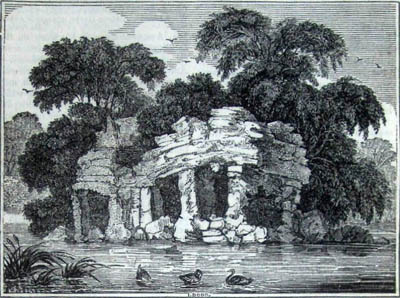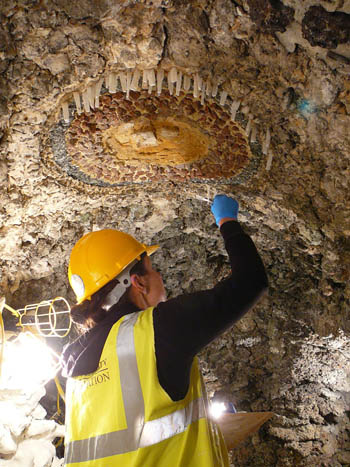
HOME





HOME
|

|

|

|

|
|
P R O F I L E |
||||
|
  Ascot Place Grotto
Ascot Place GrottoAscot Place Windsor Road Ascot Berkshire United Kingdom SL6 7GZ The grotto at Ascot Place has historically been cited as an example of the picturesque contrivance of art for the embellishment of nature. In 1831 "The Mirror" praised the taste of the estate, lying 5 miles from Windsor on the edge of Ascot Heath. According to "The Mirror", the house was built by Andrew Lindergreen Esq. and on his death was sold to Daniel Agrace, Esq. who particularly enhanced the grounds. The jewel in the crown was the grotto that was sited at the end of a artificial waterway running through the gardens. It comprised four rooms in 1831 although only one was completed at that time and used for the past time of tea drinking. The grotto was covered in white spa throughout interspersed with polished pebbles and petrifactions. The ceiling was ornamented with pendants of the same materials. When the sun shone the effect was magical. The construction of the grotto was effected by a gentleman employed by Mr Agrace for the purpose over several years named Robert Turnbull. The illustration above by Mr Hakewell is contemporary with the grotto construction. Today the estate comprises some 400 acres with the 18th century house and garden features. The present estate layout and construction dates back to 1770 to 1789. It is a private residence and there is no public access. Records of Ascot Place date back to 1339, with owners including baked beans tycoon H J 'Jack' Heinz II, Mercedes Benz heir Mick Flick, William Lidderdale, Governor of the Bank of England, and Sir Harry Liversey. The Grade II listed property was purchased for a record 19 million pounds in 1989 by the ruler of Abu Dhabi and subsequently under-went major renovations. According to representatives of the Abu Dhabi royal family at the time, which is headed by Sheik Khalifa bin Zayed Al Nahyan, Ascot Place will be brought back into active use as one of his private residences. Bracknell Forest Borough Council in 2009 approved a scheme to build a 6ft 6in brick wall around the entire estate's perimeter. The wall is more than four miles long and used enough bricks to build 150 five-bedroom houses. The cost is estimated at more than 2 million pounds. English Heritage describes the grotto as follows: The middle lake is the largest, overlooked by the house to the north, from which it was formerly reached by an avenue of conifers leading down to the stone landing stage (c 1900). The west end of the middle lake is dominated by The Grotto (Robert Turnbull c 1750-70, listed grade I), lying 150m south-west of the house, it being one of several ornamental features in this area, including the stone cascade adjacent to the north, the bridge, and a rock garden linking these features. The Grotto is an outstanding example of an ornamental romantic grotto, containing several chambers within a built-up mound of rocks and boulders, chiefly Sarsen stones, ascended on the outside via stone steps leading to the top where flat stones are provided for sitting and admiring the view over the lake to the park and house. Within, a narrow, rocky passage leads to the largest, quatrefoil-shaped chamber, dimly lit by an octagonal lantern in the roof. The walls are covered with small, glittering white quartz crystals, all placed longitudinally, with some outcroppings of purple and pink quartz crystals in large clusters. All around the edges of the roof artificial stalactites of varying length descend in an irregular double row, also covered with crystals, with some darker crystals arranged in a tall, zig-zag pattern. From here passages lead to two smaller chambers, including a tea chamber, both facing north-east and overlooking the lake and house, with decoration in similar style to the main chamber. It is now a listed Grade I structure although it had earlier been identified as under threat. The restoration detailed below enabled this description to be dropped, When the Grotto was restored in 2011 the following details were recorded by the restorers Andea Walker Conservation. The restoration was preceded by a detailed Laser scanning of the structure both internally and externally.  This then allowed the architects and their engineers to cut 'live' sections as required to determine the structure. The scanning also provided a comprehensive permanent archive of the grotto. For details of Andrea Walker Construction click their picture right. Their description is given as follows: This then allowed the architects and their engineers to cut 'live' sections as required to determine the structure. The scanning also provided a comprehensive permanent archive of the grotto. For details of Andrea Walker Construction click their picture right. Their description is given as follows:
This particular grotto is an artificial structure, created to look like a cave. A slag-lined passage from the main sarsen entrance opens into the central, asymmetrical, domed chamber. From there, a series of tunnels lead away to other chambers and smaller niche areas with wooden bench seats built into the walls. It was built beside the lake, at a level lower than the water of the lake, in order to provide high water pressure for the water system and rock pools within the chambers. Two rock pools are set into the decorative pebble floors open to the lakeside. Each pool has a pedestal surface where it is thought either a sculpture would have been set (possibly Orpheus), or a water feature would have cascaded water. The core structure of the grotto is made of bricks and mortar. The walls, on the interior, are faced with lime render and, either decorated with lumps of slag, flint, clinker and tufa in varying sizes and coated with a white and yellow lime wash, or decorated with flint up to dado level, with oblong hand-cut flakes of quartz and mica crystals stretching upward, on to the ceiling. In the passages between the chambers, the ceilings are faced with lime render and crystals in patterns. Man-made stalactites hang in clusters from the chamber ceilings. Made of lath and plaster construction on wood timber bases, they too are faced with render and decorated with crystals, broken up by red quartz in zigzag patterns. To provide the grotto with light, candle niches are built into the walls. Light also comes through skylights and lantern windows high up in the chamber ceilings, and from passages leading towards the lakeside of the grotto. Each chamber is deceptively tall with ceilings as high as five to six meters. Ascot Grotto is one of the landmark grottoes in England and as such is highly rated, albeit not accessible to the public. For more information about the restoration click on website below. Website: Click Here ADDITIONAL INFORMATION   
GREAT BRITISH GROTTO GRADING
CONSTRAINTS Not open to the public, On private property FACILITIES Grottoes - more than one LANDSCAPE Inland Water, Park or Garden, Urban REGION England - Southern THE FEATURES PRESENT +A created provenance that links it to ancient mythology or legend, +Cared for and maintained in good condition, +Crystals and/or minerals, either natural or simulated, +Dark and mysterious chambers and cave like spaces, +External rock structures, either real or simulated, +Fossils and/or shells incorporated into the decor, +Internal stonework that is natural, recycled or simulated to give a subterranean decor, +Sacred spring or integral water feature, +Stunning setting and location, +Viewing points from within to an intriguing landscape outside, GRADED TEN Top Score WOW! |
||||
|